I have finished the game, and my prior posts are needed to understand this one.
The plane kept being obnoxious. Lucian Smith gave a hint in the comments that I was genuinely just missing some information. Having no idea what that information was, I combed through the entire game, and had no luck.
I didn’t want to look at a full walkthrough, so I checked for any books from the 80s that covered the game. Kim Schuette had, but I’ve used his book plenty of times before, and I came across one I’d never cracked open.

From the Museum of Computer Adventure Games.
I did find out what I was missing — and I hope you all are as infuriated as I was — but first I did want to spend a little more time on the book itself, because it was published in 1984 (after On-Line became Sierra On-Line, but before King’s Quest 1) and it rather delightfully includes some contemporary thoughts about these games which are not exactly congruent to modern opinion. I’m just going to wander through a few of these and then we can get back to Rungistan.
All the games can be played with either a monochrome or a color monitor. If you have a choice, you will probably want to use a color monitor to fully appreciate the fine pictures in some of the games.
I love the advice that you need to go out of your way to upgrade to color. On a number of the games the authors again emphasize they play particularly well with color (Rungistan, the book says, works fine on a black and white screen).
In the area of hi-res puzzle solving adventures, Sierra On-Line stands out. They offer seven of these adventures, far more than any other company. The graphics and playability are uniformly good.
Uniformly good, eh?
Time Zone is a crowning achievement in adventures. Both the puzzles and the graphics are of the highest order-and there is enough here to keep you busy for quite a long time.
I probably liked Time Zone more than anyone who has played it in a long time, but it is boggling to me even in 1984 to claim the puzzles and graphics are of the highest order.
The game includes some simple animation. The full screen can change several times for a single move, to give you the feeling of actual motion. This is fun for a few turns, but it becomes repetitive and boring fairly quickly.
This is about Mask of the Sun, which the authors also found brutally hard. They linked Rungistan’s animation, which they called “top-of-the-line”. Sherwood Forest, which we haven’t gotten to yet, incidentally wins the “fast graphics award” for quick load times.
Speaking of Rungistan, let’s get back into it–

I was struggling to control a plane, and went off to look for directions. It turns out they are here, at the mailbox:
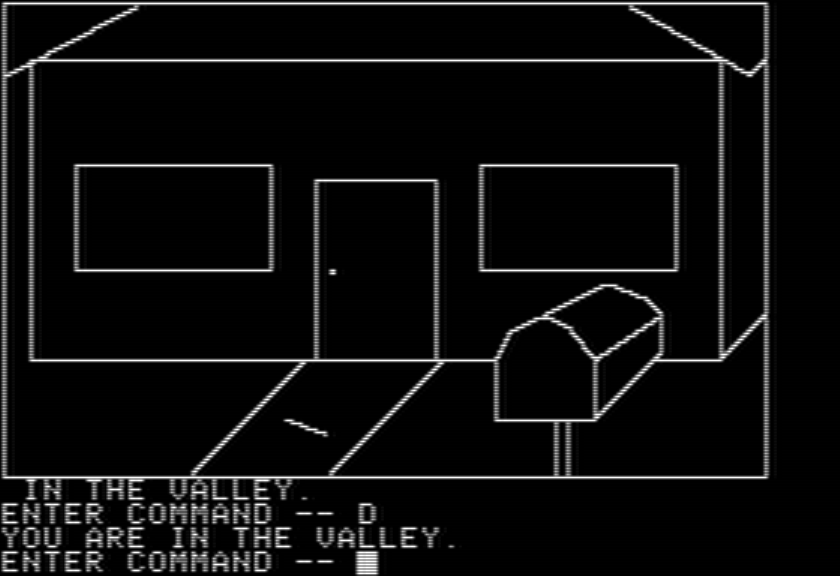
You see that line on the ground? I did suspect already it was something, and ran through
LOOK LINE
LOOK GROUND
LOOK MARK
LOOK FLOOR
LOOK VALLEY
LOOK ENTRANCE
LOOK DOWN
and even, yes
LOOK WRITING
and in each and every case, the game responds I DON’T UNDERSTAND. (Except LOOK DOWN, where nothing happens, I don’t know why.) I discarded the line as just a graphical feature.
The book I mentioned, bafflingly, mentioned graffiti. I went back and finally hit upon LOOK PATH:
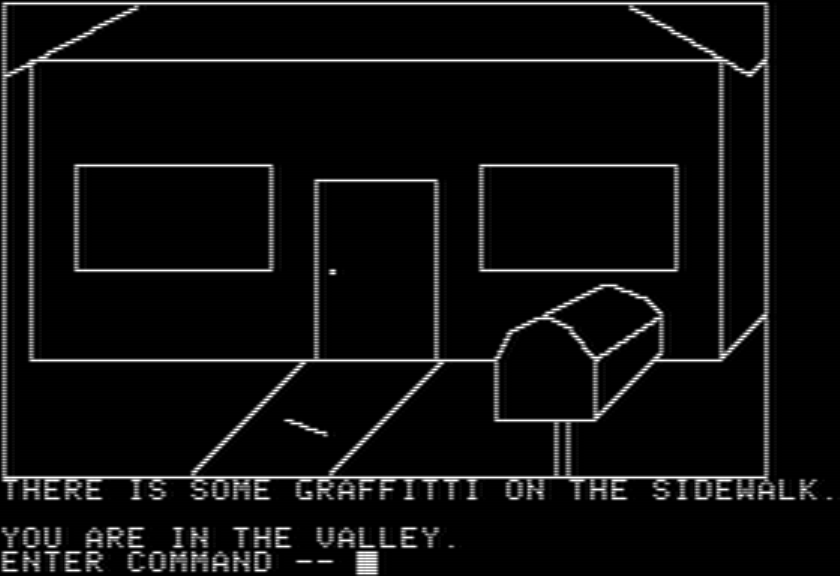
aaaaaaaaaaaaaaaaaaaaaaaaa
The graffiti has the word “NESSEN”, which is simply directions for the plane. So type N, E, S, S, E, N after FLY PLANE, and you’ll land safely.
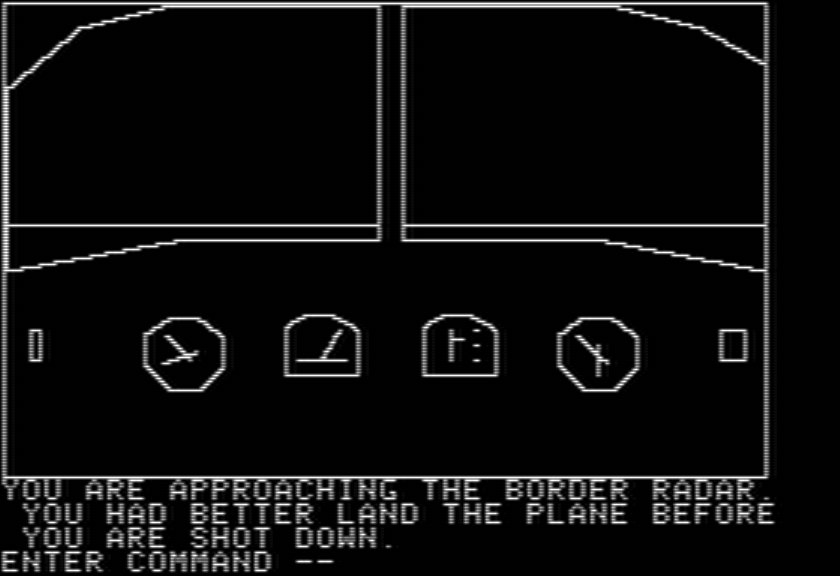
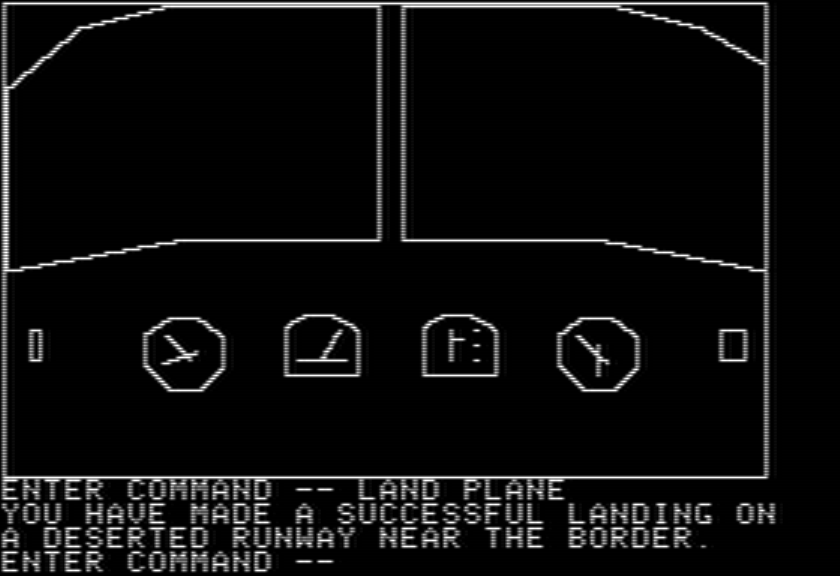
This is nearly at the end. There’s a blockade of boulders, where, mysteriously, the dynamite that previously explodes in your hand now will pause after you light it, letting you THROW DYNAMITE and get away as there’s a fuse-shortening animation.
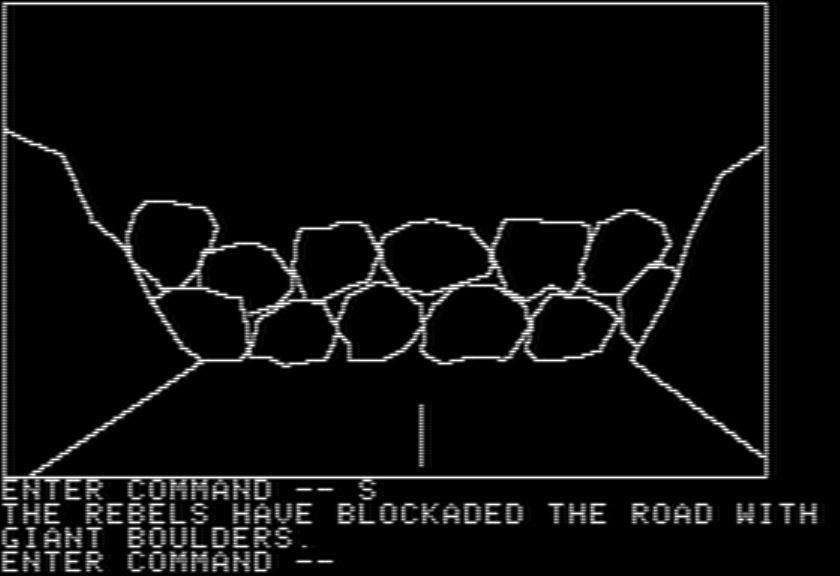
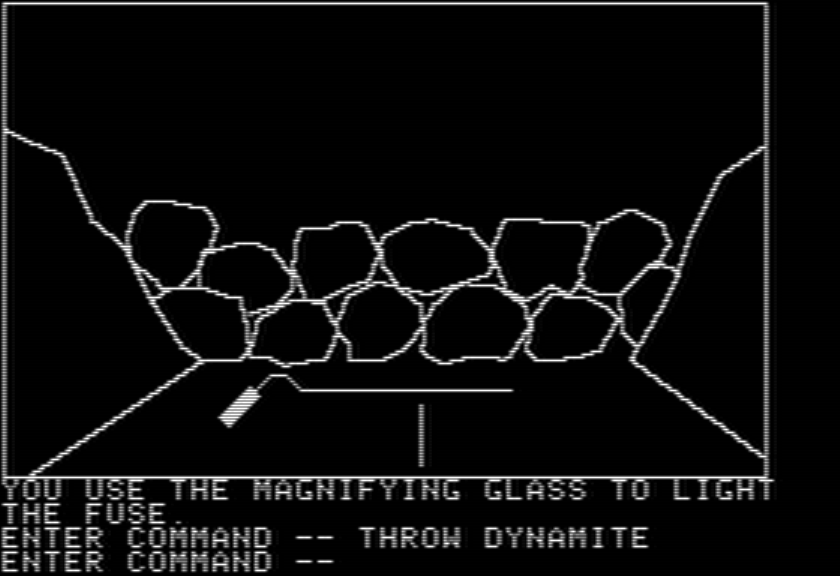
Step away, step back: the road is clear. Then you head south to a minor trap.
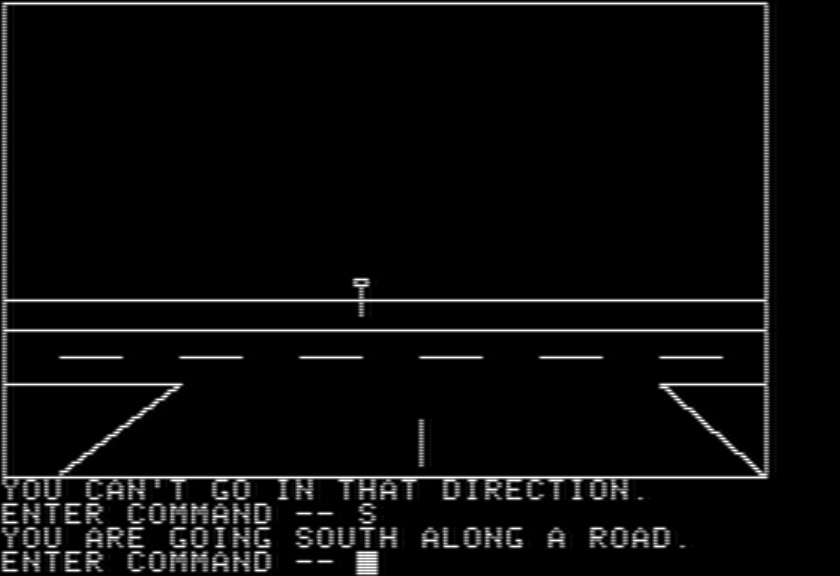
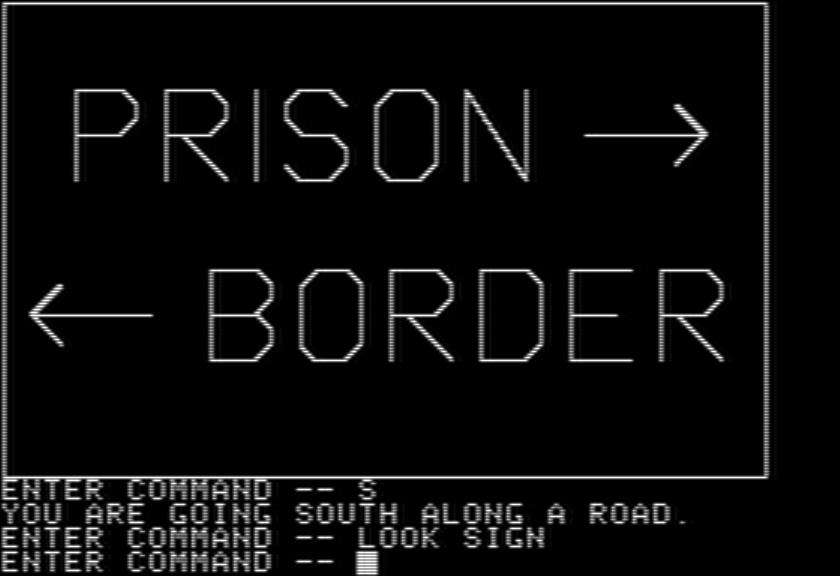
Remember, you are facing south. It may appear “west” is the way you want but the directions are reversed.
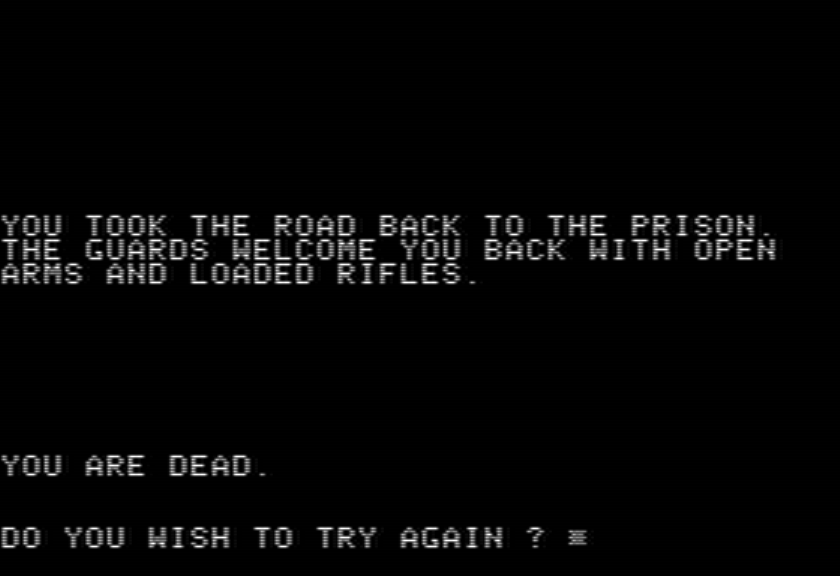
I understood the trick but I wanted to see the death text anyway.
Going east, the correct way, is the final obstacle: a guard at a gate. Here I found I needed the booze-that-makes-you-go-blind, not the empty bottle.
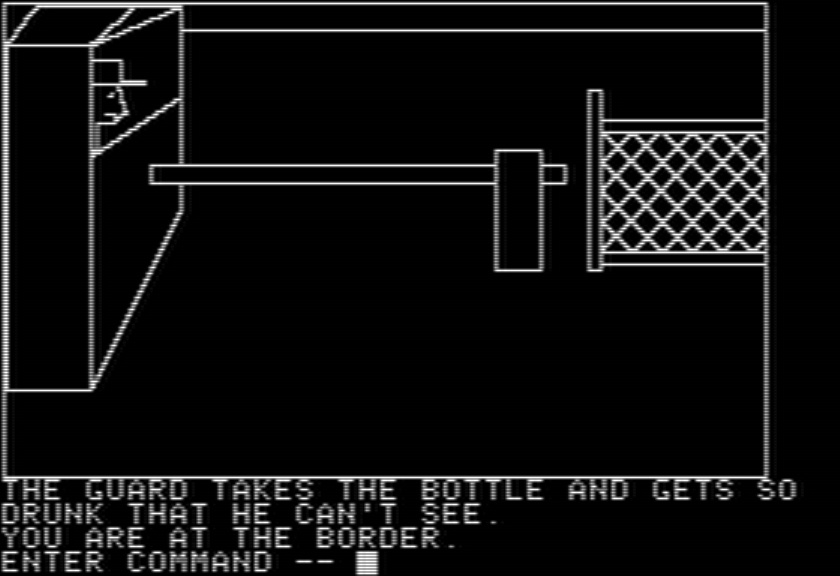
LIFT GATE (which took a while to find) will let you plow to the end.
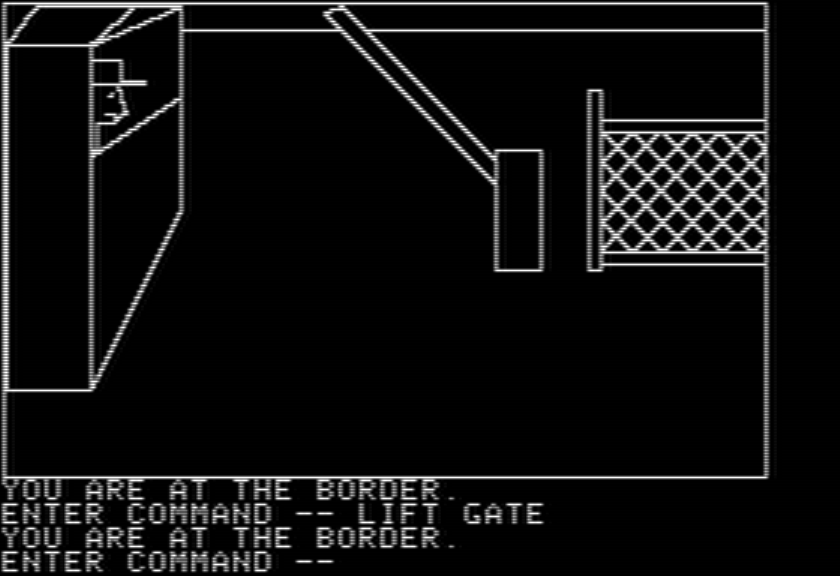
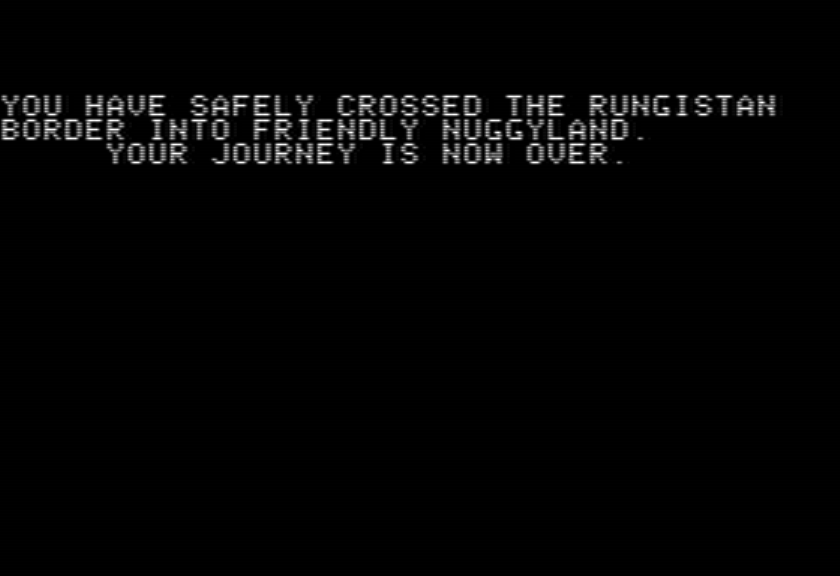
I honestly on the balance had fun, even given the moment of infuriation. But let’s talk about softlocks. It’s the same sort that show up in the biome journey of Wizard and the Princess, but made even more aggressive.
I’m acclimated to the games of this era (much like the four authors of the book who have nothing but praise for the early Sierra games) so I was immediately planning and expecting that a biome journey would lend itself to such behavior. With the bottle at the very end, which could have tripped me up, I already had two save files running with the anticipation I’d need either one or the other. I was even anticipating the possibility of simply having to repeat the game: that was how it went sometimes, just like replying the early levels of an arcade game. Solving the game isn’t about the immediate moment, but correctly choreographing an entire sequence of moves.
I am still fully aware it is not a wise design choice. It does lend itself to some unique effects — every choice is a tradeoff rather than fully good or bad — but I have a hard time imagining where I’d use this kind of linear softlock in a modern game.
As a historical artifact, I do want to emphasize the animation in Rungistan is integrated in a novel way; Mask of the Sun approached the same ideas but not as fully. I’m especially curious what Bob Blauschild has in store for his other 1982 game, Critical Mass, which switches the action to color.

From Mobygames.
BONUS POINT 1: As observed in the comments for my last post, this doesn’t really seem to be central Africa (as the instructions say) or any continent in particular given the “-stan” ending and the sahuaro cactus and the El Presidente reference and so forth. (Tucson has Mount Lemmon so you can go skiing, technically. In the deep winter.) The game leans into the smörgåsbord-of-locations idea heavily enough I suspect identifying a continent was a late addition.
BONUS POINT 2: This was published in Japanese by Starcraft for various systems. The screenshots are neat; they took black and white as a style rather than a fast-Apple-II-animation restriction and ran with it.
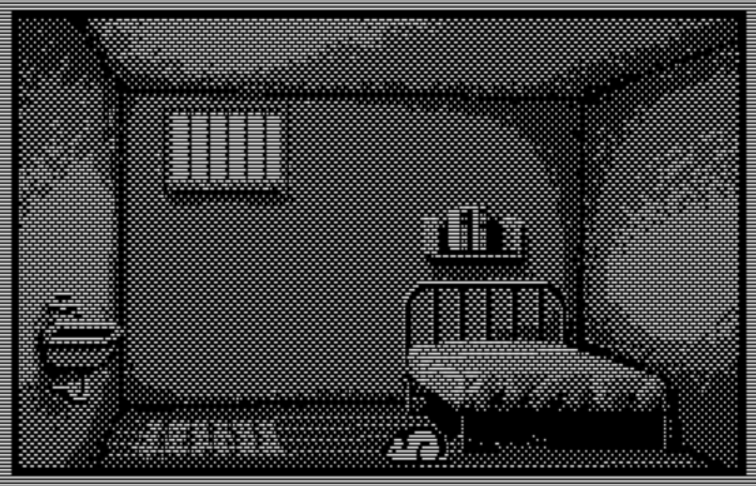
BONUS POINT 3: SouprMatt from Mastodon shared a story I wanted to pass on:
I remember this game very well! My late father played all night with one of his friends, and got to the end, only to realize they’d failed to pick up an important item early in the game. My father, instead of re-doing the entire game, figured out how to hack the save-game file and put the item into his inventory. Then reloaded the game and finished it!
A few random thoughts. It’s only recently that there have been efforts in media to mainstream more accurate depictions of non western culture and people for sheet entertainment value. Hollywood has a long storied history of black and yellow face, of course. As recently as Indiana Jones and the Temple of Doom (which was around the time this game was released) portrayed Indian culture (and food) in a horrific and offensive way. Just look to the Graumann’s Chinese theater in Hollywood to see a fall and wildly inaccurate depiction of what a white guy in Hollywood (who had probably never been to China) imagined what a Chinese theater looked like. It didn’t matter that it wasn’t accurate, it’s a spectacle and people pay for spectacle. I imagine Blauschild is a child of the 50s and as such is probably blissfully unencumbered by any obligation to portray the people and culture of central Asia/Africa/Latin America/wherever with any degree of accuracy.
And in a completely different note, do you pronounce Rungistan with a hard or soft G? In my house we said it with the soft G like giraffe, but in her YouTube “lo-fi let’s play” video Leigh Alexander pronounces it with a hard G like gift.
Maybe you could reach out to Blauschild for a definitive Steve Wilhite “jiff not giff” clarification? (It’s definitely Jiff, by the way :)
I had this one as a kid, and definitely used a hard G when pronouncing it.
Interesting points on the cultural insensitivity aspect, although as I mentioned in another comment, I think a lot of it may simply come from that certain Cold War era “fake country” trope that was ubiquitous in TV shows of the era, in particular.
I encourage anytime interest in this topic to watch a great documentary called “Hollywood Chinese”
It dives into yellow face in cinematic history. There’s one white actress who won an Oscar for her portrayal of a Chinese peasant woman in The Good Earth. She laments how actors must be cast “to type” these days (2007). Look at a Russian guy (Yul Brynner) winning an Oscar for playing a Thai king in The King and I.
it’s quite remarkable that so much has changed in so little time. These games are really time capsules of their era, and if the era the designers themselves grew up in.